Question Number 42948 by ajfour last updated on 05/Sep/18
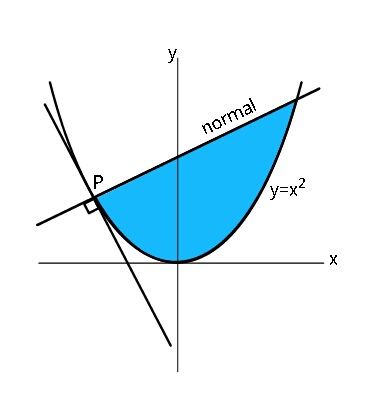
Commented by ajfour last updated on 05/Sep/18

$${Find}\:{coordinates}\:{of}\:{point}\:{P}\:,\:{if} \\ $$$${the}\:{coloured}\:{area}\:{is}\:{a}\:{minimum}. \\ $$
Commented by MJS last updated on 05/Sep/18
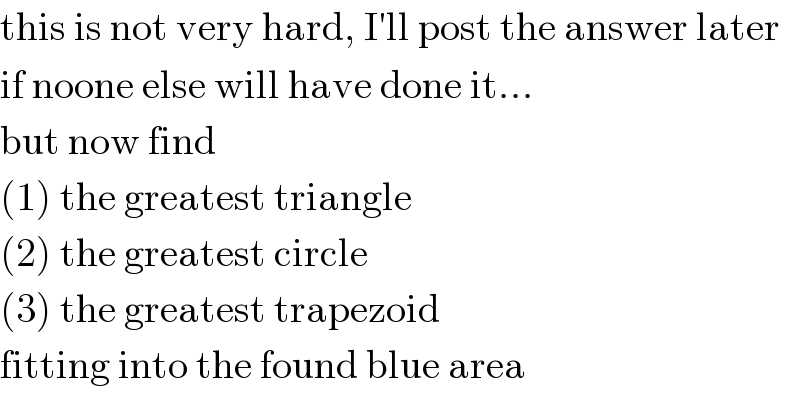
$$\mathrm{this}\:\mathrm{is}\:\mathrm{not}\:\mathrm{very}\:\mathrm{hard},\:\mathrm{I}'\mathrm{ll}\:\mathrm{post}\:\mathrm{the}\:\mathrm{answer}\:\mathrm{later} \\ $$$$\mathrm{if}\:\mathrm{noone}\:\mathrm{else}\:\mathrm{will}\:\mathrm{have}\:\mathrm{done}\:\mathrm{it}… \\ $$$$\mathrm{but}\:\mathrm{now}\:\mathrm{find} \\ $$$$\left(\mathrm{1}\right)\:\mathrm{the}\:\mathrm{greatest}\:\mathrm{triangle} \\ $$$$\left(\mathrm{2}\right)\:\mathrm{the}\:\mathrm{greatest}\:\mathrm{circle} \\ $$$$\left(\mathrm{3}\right)\:\mathrm{the}\:\mathrm{greatest}\:\mathrm{trapezoid} \\ $$$$\mathrm{fitting}\:\mathrm{into}\:\mathrm{the}\:\mathrm{found}\:\mathrm{blue}\:\mathrm{area} \\ $$
Commented by malwaan last updated on 06/Sep/18

$$\mathrm{please}\:\mathrm{solve}\:\mathrm{it} \\ $$
Commented by ajfour last updated on 06/Sep/18
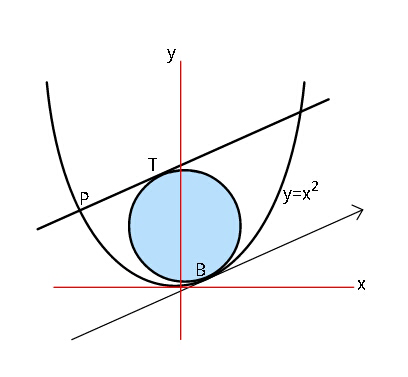
Commented by ajfour last updated on 06/Sep/18
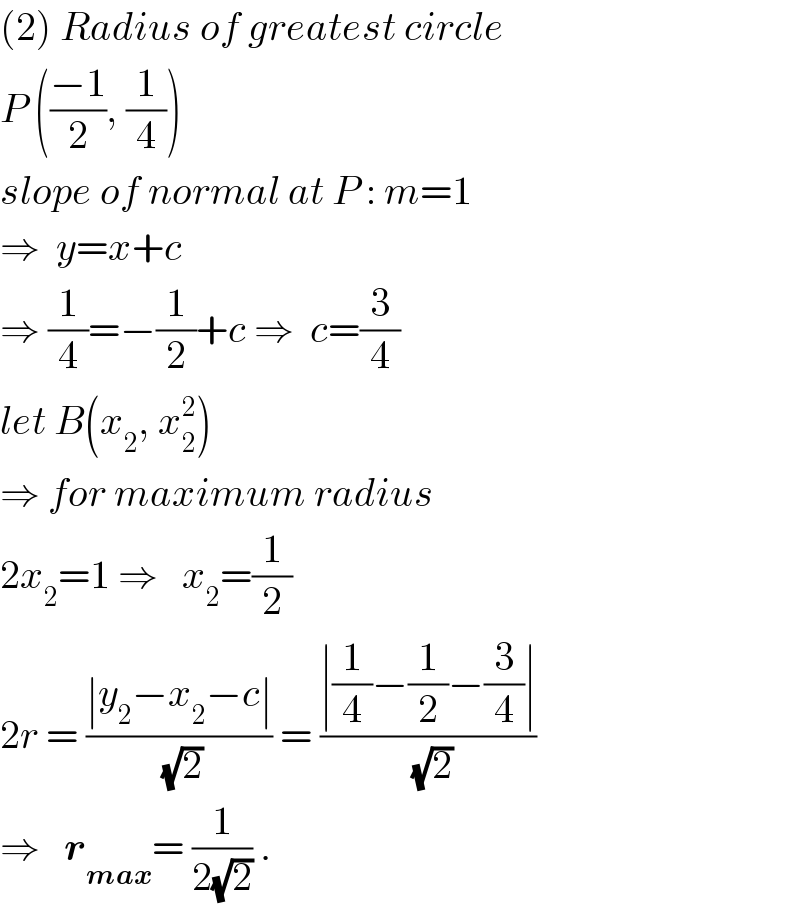
$$\left(\mathrm{2}\right)\:{Radius}\:{of}\:{greatest}\:{circle} \\ $$$${P}\:\left(\frac{−\mathrm{1}}{\mathrm{2}},\:\frac{\mathrm{1}}{\mathrm{4}}\right) \\ $$$${slope}\:{of}\:{normal}\:{at}\:{P}\::\:{m}=\mathrm{1} \\ $$$$\Rightarrow\:\:{y}={x}+{c} \\ $$$$\Rightarrow\:\frac{\mathrm{1}}{\mathrm{4}}=−\frac{\mathrm{1}}{\mathrm{2}}+{c}\:\Rightarrow\:\:{c}=\frac{\mathrm{3}}{\mathrm{4}} \\ $$$${let}\:{B}\left({x}_{\mathrm{2}} ,\:{x}_{\mathrm{2}} ^{\mathrm{2}} \right) \\ $$$$\Rightarrow\:{for}\:{maximum}\:{radius} \\ $$$$\mathrm{2}{x}_{\mathrm{2}} =\mathrm{1}\:\Rightarrow\:\:\:{x}_{\mathrm{2}} =\frac{\mathrm{1}}{\mathrm{2}} \\ $$$$\mathrm{2}{r}\:=\:\frac{\mid{y}_{\mathrm{2}} −{x}_{\mathrm{2}} −{c}\mid}{\:\sqrt{\mathrm{2}}}\:=\:\frac{\mid\frac{\mathrm{1}}{\mathrm{4}}−\frac{\mathrm{1}}{\mathrm{2}}−\frac{\mathrm{3}}{\mathrm{4}}\mid}{\:\sqrt{\mathrm{2}}} \\ $$$$\Rightarrow\:\:\:\boldsymbol{{r}}_{\boldsymbol{{max}}} =\:\frac{\mathrm{1}}{\mathrm{2}\sqrt{\mathrm{2}}}\:. \\ $$
Answered by ajfour last updated on 05/Sep/18
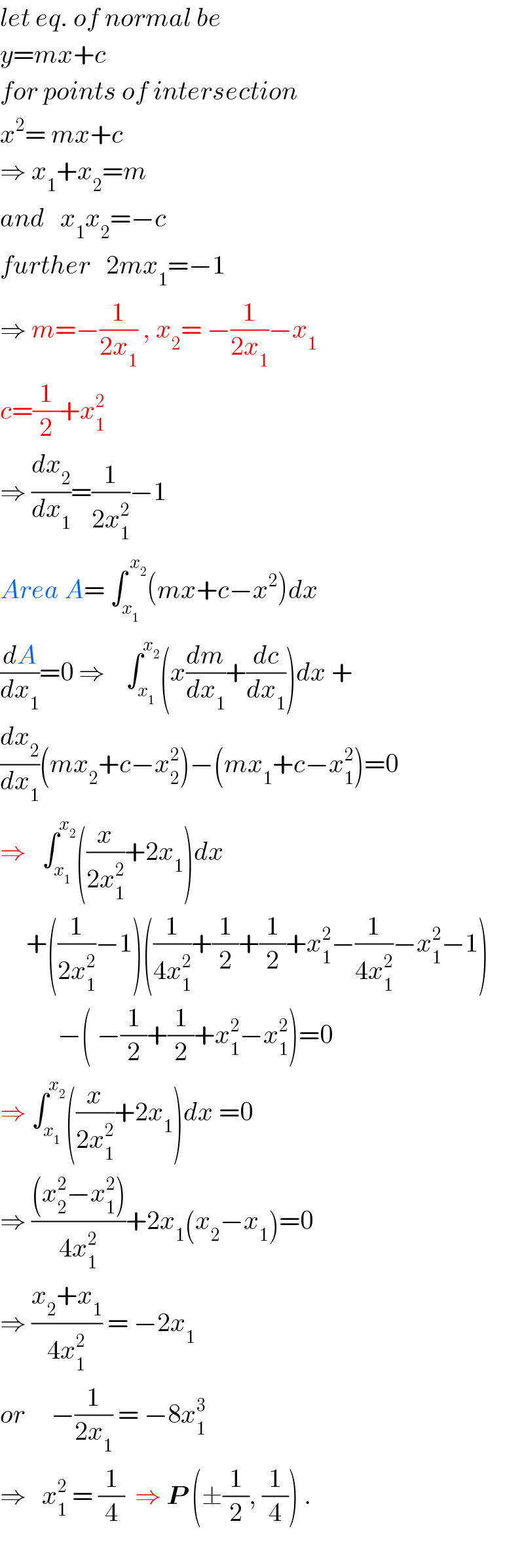
$${let}\:{eq}.\:{of}\:{normal}\:{be} \\ $$$${y}={mx}+{c} \\ $$$${for}\:{points}\:{of}\:{intersection} \\ $$$${x}^{\mathrm{2}} =\:{mx}+{c} \\ $$$$\Rightarrow\:{x}_{\mathrm{1}} +{x}_{\mathrm{2}} ={m}\:\: \\ $$$${and}\:\:\:{x}_{\mathrm{1}} {x}_{\mathrm{2}} =−{c} \\ $$$${further}\:\:\:\mathrm{2}{mx}_{\mathrm{1}} =−\mathrm{1} \\ $$$$\Rightarrow\:{m}=−\frac{\mathrm{1}}{\mathrm{2}{x}_{\mathrm{1}} }\:,\:{x}_{\mathrm{2}} =\:−\frac{\mathrm{1}}{\mathrm{2}{x}_{\mathrm{1}} }−{x}_{\mathrm{1}} \\ $$$${c}=\frac{\mathrm{1}}{\mathrm{2}}+{x}_{\mathrm{1}} ^{\mathrm{2}} \\ $$$$\Rightarrow\:\frac{{dx}_{\mathrm{2}} }{{dx}_{\mathrm{1}} }=\frac{\mathrm{1}}{\mathrm{2}{x}_{\mathrm{1}} ^{\mathrm{2}} }−\mathrm{1} \\ $$$${Area}\:{A}=\:\int_{{x}_{\mathrm{1}} } ^{\:{x}_{\mathrm{2}} } \left({mx}+{c}−{x}^{\mathrm{2}} \right){dx} \\ $$$$\frac{{dA}}{{dx}_{\mathrm{1}} }=\mathrm{0}\:\Rightarrow\:\:\:\:\int_{{x}_{\mathrm{1}} } ^{{x}_{\mathrm{2}} } \left({x}\frac{{dm}}{{dx}_{\mathrm{1}} }+\frac{{dc}}{{dx}_{\mathrm{1}} }\right){dx}\:+ \\ $$$$\frac{{dx}_{\mathrm{2}} }{{dx}_{\mathrm{1}} }\left({mx}_{\mathrm{2}} +{c}−{x}_{\mathrm{2}} ^{\mathrm{2}} \right)−\left({mx}_{\mathrm{1}} +{c}−{x}_{\mathrm{1}} ^{\mathrm{2}} \right)=\mathrm{0} \\ $$$$\Rightarrow\:\:\:\int_{{x}_{\mathrm{1}} } ^{{x}_{\mathrm{2}} } \left(\frac{{x}}{\mathrm{2}{x}_{\mathrm{1}} ^{\mathrm{2}} }+\mathrm{2}{x}_{\mathrm{1}} \right){dx} \\ $$$$\:\:\:\:\:+\left(\frac{\mathrm{1}}{\mathrm{2}{x}_{\mathrm{1}} ^{\mathrm{2}} }−\mathrm{1}\right)\left(\frac{\mathrm{1}}{\mathrm{4}{x}_{\mathrm{1}} ^{\mathrm{2}} }+\frac{\mathrm{1}}{\mathrm{2}}+\frac{\mathrm{1}}{\mathrm{2}}+{x}_{\mathrm{1}} ^{\mathrm{2}} −\frac{\mathrm{1}}{\mathrm{4}{x}_{\mathrm{1}} ^{\mathrm{2}} }−{x}_{\mathrm{1}} ^{\mathrm{2}} −\mathrm{1}\right) \\ $$$$\:\:\:\:\:\:\:\:\:\:\:−\left(\:−\frac{\mathrm{1}}{\mathrm{2}}+\frac{\mathrm{1}}{\mathrm{2}}+{x}_{\mathrm{1}} ^{\mathrm{2}} −{x}_{\mathrm{1}} ^{\mathrm{2}} \right)=\mathrm{0} \\ $$$$\Rightarrow\:\int_{{x}_{\mathrm{1}} } ^{{x}_{\mathrm{2}} } \left(\frac{{x}}{\mathrm{2}{x}_{\mathrm{1}} ^{\mathrm{2}} }+\mathrm{2}{x}_{\mathrm{1}} \right){dx}\:=\mathrm{0} \\ $$$$\Rightarrow\:\frac{\left({x}_{\mathrm{2}} ^{\mathrm{2}} −{x}_{\mathrm{1}} ^{\mathrm{2}} \right)}{\mathrm{4}{x}_{\mathrm{1}} ^{\mathrm{2}} }+\mathrm{2}{x}_{\mathrm{1}} \left({x}_{\mathrm{2}} −{x}_{\mathrm{1}} \right)=\mathrm{0} \\ $$$$\Rightarrow\:\frac{{x}_{\mathrm{2}} +{x}_{\mathrm{1}} }{\mathrm{4}{x}_{\mathrm{1}} ^{\mathrm{2}} }\:=\:−\mathrm{2}{x}_{\mathrm{1}} \\ $$$${or}\:\:\:\:\:−\frac{\mathrm{1}}{\mathrm{2}{x}_{\mathrm{1}} }\:=\:−\mathrm{8}{x}_{\mathrm{1}} ^{\mathrm{3}} \\ $$$$\Rightarrow\:\:\:{x}_{\mathrm{1}} ^{\mathrm{2}} \:=\:\frac{\mathrm{1}}{\mathrm{4}}\:\:\Rightarrow\:\boldsymbol{{P}}\:\left(\pm\frac{\mathrm{1}}{\mathrm{2}},\:\frac{\mathrm{1}}{\mathrm{4}}\right)\:. \\ $$$$ \\ $$
Commented by ajfour last updated on 05/Sep/18

$${Have}\:{i}\:{solved}\:{it}\:{correct},\:{Sir}\:? \\ $$
Commented by MJS last updated on 05/Sep/18

$$\mathrm{yes}.\:\mathrm{with}\:{y}={ax}^{\mathrm{2}} \:\mathrm{we}\:\mathrm{get}\:{p}=\pm\frac{\mathrm{1}}{\mathrm{2}{a}}\:\mathrm{and}\:\mathrm{blue} \\ $$$$\mathrm{area}=\frac{\mathrm{4}}{\mathrm{3}{a}^{\mathrm{2}} } \\ $$
Commented by ajfour last updated on 05/Sep/18

$${Thanks}\:{Sir}. \\ $$
